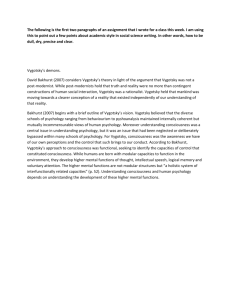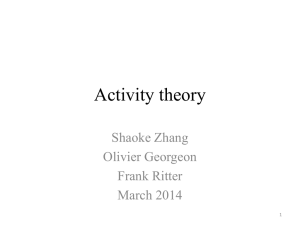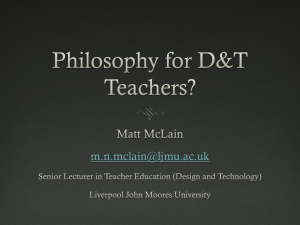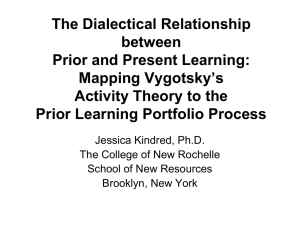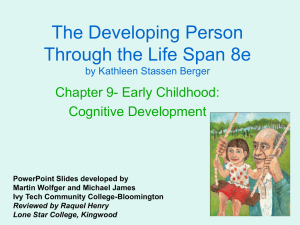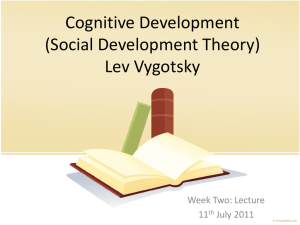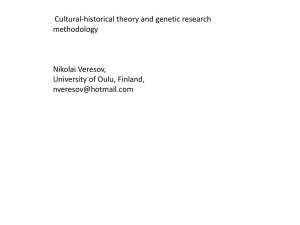When is a concept really a concept
advertisement
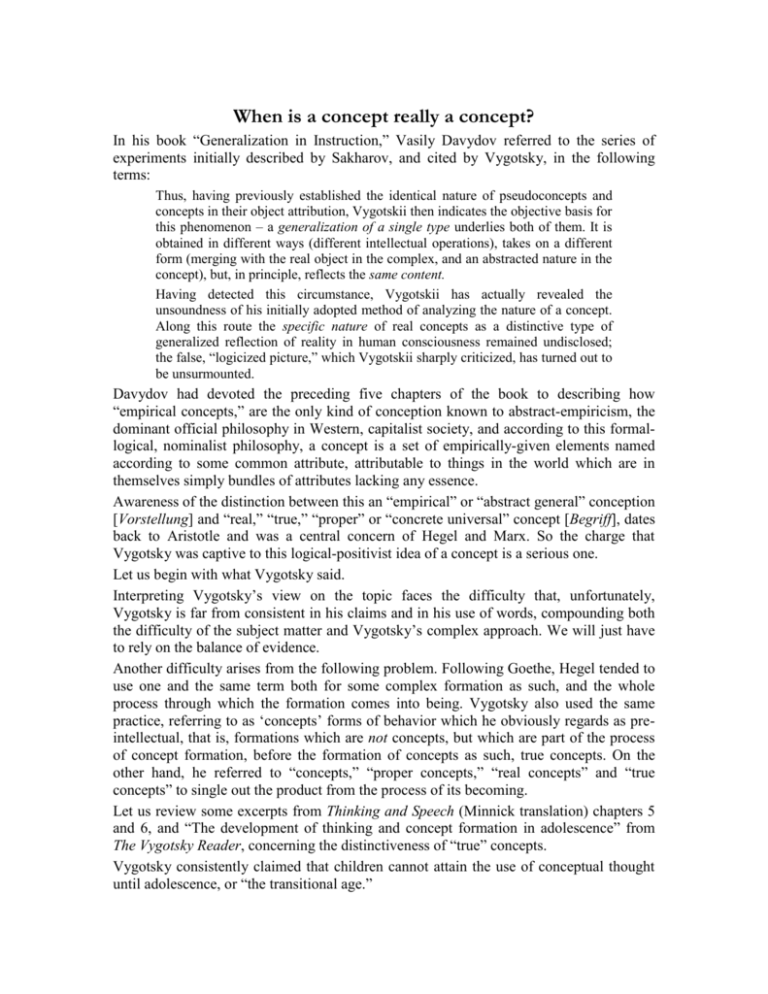
When is a concept really a concept? In his book “Generalization in Instruction,” Vasily Davydov referred to the series of experiments initially described by Sakharov, and cited by Vygotsky, in the following terms: Thus, having previously established the identical nature of pseudoconcepts and concepts in their object attribution, Vygotskii then indicates the objective basis for this phenomenon – a generalization of a single type underlies both of them. It is obtained in different ways (different intellectual operations), takes on a different form (merging with the real object in the complex, and an abstracted nature in the concept), but, in principle, reflects the same content. Having detected this circumstance, Vygotskii has actually revealed the unsoundness of his initially adopted method of analyzing the nature of a concept. Along this route the specific nature of real concepts as a distinctive type of generalized reflection of reality in human consciousness remained undisclosed; the false, “logicized picture,” which Vygotskii sharply criticized, has turned out to be unsurmounted. Davydov had devoted the preceding five chapters of the book to describing how “empirical concepts,” are the only kind of conception known to abstract-empiricism, the dominant official philosophy in Western, capitalist society, and according to this formallogical, nominalist philosophy, a concept is a set of empirically-given elements named according to some common attribute, attributable to things in the world which are in themselves simply bundles of attributes lacking any essence. Awareness of the distinction between this an “empirical” or “abstract general” conception [Vorstellung] and “real,” “true,” “proper” or “concrete universal” concept [Begriff], dates back to Aristotle and was a central concern of Hegel and Marx. So the charge that Vygotsky was captive to this logical-positivist idea of a concept is a serious one. Let us begin with what Vygotsky said. Interpreting Vygotsky’s view on the topic faces the difficulty that, unfortunately, Vygotsky is far from consistent in his claims and in his use of words, compounding both the difficulty of the subject matter and Vygotsky’s complex approach. We will just have to rely on the balance of evidence. Another difficulty arises from the following problem. Following Goethe, Hegel tended to use one and the same term both for some complex formation as such, and the whole process through which the formation comes into being. Vygotsky also used the same practice, referring to as ‘concepts’ forms of behavior which he obviously regards as preintellectual, that is, formations which are not concepts, but which are part of the process of concept formation, before the formation of concepts as such, true concepts. On the other hand, he referred to “concepts,” “proper concepts,” “real concepts” and “true concepts” to single out the product from the process of its becoming. Let us review some excerpts from Thinking and Speech (Minnick translation) chapters 5 and 6, and “The development of thinking and concept formation in adolescence” from The Vygotsky Reader, concerning the distinctiveness of “true” concepts. Vygotsky consistently claimed that children cannot attain the use of conceptual thought until adolescence, or “the transitional age.” It is only when the child turns into an adolescent, that the final transition into the realm of thinking in concepts can occur. These processes mature only in the transitional age. It is only at this point that the intellectual functions which form the mental basis for the process of concept formation are constituted and developed. It is only in the transitional age that the child completes the third stage in the development of his intellect, that he reaches the point where he is thinking in concepts. Only with the transformation of the child that occurs in adolescence does the decisive transition to thinking in concepts become possible. And this relationship is connected to the new social position of the adolescent. The tasks that are posed for the maturing adolescent by the social environment – tasks that are associated with his entry into the cultural, professional, and social life of the adult world – are an essential functional factor in the formation of concepts. Repeatedly, this factor points to the mutually conditioned nature, the organic integration, and the internal unity of content and form in the development of thinking. It would be a mistake to ignore or fail to recognize the significance of the life-task as a factor that nourishes and directs intellectual development in the transitional age. However, it would also be a mistake to view this aspect of causal-dynamic development as the basic mechanism of the problem of concept development or as the key to this problem. The true concept ... indicates a high level of socialization of thinking. Concepts arise as solutions to problems: The concept is formed only with the emergence of a need that can be satisfied in the concept, only in the process of some meaningful goal-oriented activity directed on the attainment of a particular goal or the on resolution of a definite task. Concepts are always formed during a process of finding a solution to some problem facing the adolescent’s thinking process. The creation of the concept is dependent on a solution to this problem being found. The subject must be faced with a task that can only be resolved through the formation of concepts. The formation of concepts occurs whenever the adolescent is faced with the task of resolving some problem. The concept arises only as a result of the solution of this problem. What is central to this process is the functional use of the sign or word as the means through which the adolescent masters and subordinates his own mental operations and directs their activity in the resolution of the tasks which face him. The functional conditions of the concept’s origins are ... in connection with a particular task or need that arises in thinking, in connection with understanding or communication and with the fulfillment of a task or instruction that cannot be carried out without the formation of the concept. Concepts arise as integral parts of practical semantic structures which go beyond associations. The concept exists only as an integral and inseparable part of the general framework of a judgement. When, based on the use of a word as a means of concept formation, a particular significative structure comes into being which we feel justified in calling a concept in the true sense of the word. The concept actually does find its natural place in judgments and conclusions, acting as a constituent of them. The child who responds with the word “big” when presented with the word “house” or with the phrase “apples hang from it” when presented with the word “tree” proves that the concept exists only within a general structure of judgments, that it exists only as an inseparable part of that structure. The concept arises in the intellectual operation. It is not the play of associations that leads to its construction. Vygotsky always emphasizes the distance separating “true” concepts from complexes. [Complexes] fulfil a similar function to that of concepts in solving similar problems, but an experimental analysis reveals that these equivalents of our concepts, in their psychological nature, their composition, their structure and the type of function they perform, have the same relationship to the latter as an embryo to the mature organism. To identify one with the other would be to ignore the lengthy process of development and to place an equals sign between its beginning and its final stage. Their [pseudoconcepts] psychological nature, their constituents, their structure, and their mode of activity differ significantly from those of the true concept. The complexes formed during this second stage are constructed in accordance with entirely different laws of thinking than are concepts. Genotypically, in accordance with its emergence, its development, and the causal-dynamic connections which underlie it, the pseudoconcept is clearly not a concept. In its external characteristics, the pseudoconcept is as similar to true concept as the whale is to the fish. ... the pseudoconcept is related to complexive thinking and the whale to the mammals. This complex is a form of generalization that is constructed in accordance with entirely different laws than the true concept. This complex [the pseudoconcept] contains the kernel of the future concept that is germinating within it. And concepts indicate abstract not concrete thinking: The pseudoconcept, ... is the bridge that lies between the child’s concrete and abstract thinking. It is important to make the distinction between word meaning and object relatedness. The child’s words correspond to those of the adult in their object relatedness; they indicate the same objects. ... They do not, however, correspond in meaning. The child and adult understand each other with the pronunciation of the word “dog” because they relate the word to the same object, because they have the same concrete content in mind. However, one thinks of the concrete complex “dog” and the other of the abstract concept “dog.” All these claims make it undeniable that Vygotsky did not see “true” concepts simply as the end point of the development of complexes, but as a qualitatively distinct mode of thought arising under distinct and different conditions. None of the above quotes give us a clear explanation of how the distinctive character of true concepts arises, but they do give a number of suggestions. A concept arises as the solution to a problem, especially those problems with social origin and significance, and arise as a part of a system of judgments involving non-empirical categories. The concept is an active relation to the world, as opposed to a passive contemplative relation, tied up with activity rather than observation. Vygotsky does devote a chapter in Thinking and Speech to the development of scientific concepts, but scientific concepts are to Vygotsky merely the microcosm for a number of different types of true concept, such as literary/aesthetic concepts, social/customary concepts, religious concepts and so on. Concepts can be very close to the matters which concern people in their everyday life, but as is the case with scientific concepts, true concepts always have their origin in institutions of some kind, existing independently of the circumstances of everyday life and are part of some regulated system of relations and activities. The observations we have quoted relate only to true concepts and not to the narrower category of scientific concepts. It is worth making clear at this point, that whatever the claims of logical positivists and others, it is absolutely ruled out that a true concept can be arrived at by way of either the abstraction of empirical attributes or the generalization of objects according to empirical attributes. In fact, true concepts cannot be in any tied in any way to empirical attributes of things. The formation of a true concept entails a complete break from empirical attributes. Davydov makes this point, and more, abundantly clear in the early chapters of his book. No matter how many empirical aspects of the moon you generalize and no matter how narrowly you determine a supposedly essential attribute, you will not grasp the heavenly body which moves the tides and is believed to cause insanity, associated with women’s emotions and the budding of plants, which lights up romantic nights, marks out the monthly calendar and includes the satellites of far away planets as well as our own, etc., etc., etc. The concept of “moon” can only be grasped by letting go of all of its attributes. Nonetheless, and this is a strength of Vygotsky’s approach, the formation of a concept of “moon” which encompasses romantic evenings as well as Ganymede, is supported by the fixing in the mind of visual impressions of the moon and other conceptions. The concept presupposes sensual images at the same time as presupposing a complete break from them. In more than one way, conceptual thought is impossible without the support of stable complexes and potential concepts. Daily life would not be possible for a moment, without the use of complexes, even if they are every moment connected to concepts, even at times determined by concepts. For an adult, life entails a continual back-and-forth and interchange between complexes and concepts; concepts enter into perception, and the problematics which drive and enrich concepts grow out of contradictions within the field of perception as well as within the intellectual field. Does the “Aha-moment” when a participant in Sakharov’s experiment spots that the criterion for one of the nonsense words is “red-and-square” signal the achievement of a concept? Absolutely not. It is just not possible to replicate the formation of a true concept through “artificial concepts” that do not have a real life in an historical community, and only with difficulty can conceptual thought be scientifically demonstrated in this context. The test problem can be solved with the use only of the capacity to single out (abstract) sensuously given attributes, remember and combine them. This does not constitute conceptual thought, merely the development of the relevant faculties of attention, memory, logical thinking and so on. There is some sense in referring to the end point of the experiment as a “potential concept,” because, if the participant were able to incorporate the recognition of red-square blocks into the solution of social problems or tasks beyond the immediate context in which the red-square block is first posed to them, within a system of significant such relations, and integrate the selection into their thinking and speech, then it could become a concept. But within the context of the experiment it cannot be. The transition from complex to concept is a protracted and complex process, but one which necessarily involves a complex leap, in which absolutely non-empirical, social factors enter into the formation and enrichment of the concept. So Davydov’s main point stands, though it may be missing the target if aimed at Vygotsky: all the Sakharov experiments can reveal are the processes of formation of thinking antecedant to the formation of true concepts. Other means are needed to reveal how true concepts arise. Vygotsky was able to make only some generalized comments on this outside of the more detailed study of the formation of scientific concepts, which he observes, arise in a way completely different from “everyday concepts.” Scientific concepts are the “microcosm” of proper concepts, but they are not the only kind of real concepts. All manner of institutions (i.e., ‘objectified’ systems of activity) generate proper concepts, but the scientific project and schools where scientific (i.e., Marxist) concepts are taught in the Soviet Union, provided Vygotsky and Davydov with the best opportunity to study the formation of proper concepts. But different means were required. Davydov praised Vygotsky for the distinction he made between the “everyday concepts” (rightly called “general notions,” Davydov says), and scientific concepts. But this counterposition is not quite right. There are everyday concepts which are not scientific, but are nonetheless true concepts. Davydov believes that everyday experience, which is the social basis for “empirical concepts,” concepts which more or less correspond to abstract-empirical, formal-logical model of concepts, act as a barrier to the acquisition of scientific concepts. This must of course be a no more than relative truth, for without the support of pseudoconcepts, the pupils could not even understand what the teacher was saying, and could not carry out the simplest practical tasks. It seems to me that Davydov is right to associate the formation of proper concepts (though not these alone) with practical actions, and that Vygotsky would be in agreement with this, given everything that Vygotsky has had to say about artefact-mediated actions and other applications of the dual stimulation experimental method. The process of formation of proper concepts is indeed tied to joint artefact-mediated activity. Davydov is doubtless correct that at least in some strong sense, everyday empirical concepts act as a barrier to the substitution for them of scientific or any true concept, and the teacher must take account of this, be aware that true concepts cannot be formed by empirical generalization and abstraction and devise teaching methods which acknowledge the contradiction between conceptual knowledge and knowledge formed from the empirical generalization of experience. It is important to be aware also of the opposite danger, the kind of danger exhibited in religious schools for example, where knowledge gained by empirical generalization of the child’s own knowledge is set at so low a value that the child is absolutely under the sway of the teacher, so that they can be inculcated into a sect. This is a danger not only in schools but in all institutions that develop their own ethos and specialized language. It is to Vygotsky’s credit that despite his consciousness of the need for a leap to conceptual thought, he did not advocate creating conditions for overcoming the resistance of common sense consciousness which entails the suppression of common sense: the two types of concepts, scientific and everyday, mutually support, moderate and enrich one another. At this point I want to make just a couple of observations about Sakharov’s famous report. Sakharov died before the series of experiments was even completed, and the preservation of his report and its translation and inclusion in the immensely influential Vygotsky Reader were tributes to his work on the development of the dual stimulation experimental technique. But his report has come to be seen as a part of Vygotsky oeuvres. This is a problem, because Sakharov talks throughout only of “concepts” and never contrasts the various thought-forms found in the experiments with “true,” “real” or “proper” concepts. Now we could find quotes from Vygotsky’s analysis as well, which fail to make the distinction, but these are compensated for by a much larger mass of material where the distinction is made clear. Although Sakharov mentions that concepts arise through the solution of problems: “the development of a concept plays the role of an instrument for achieving certain ends ... The preconditions for concept formation are present only when the subject has a goal conception, a task. Under the influence of a task and the determining tendencies deriving from it, mental processes undergo an abrupt change.” it is clear that he nonetheless regards concepts as the abstraction of one or more attributes of things used to form a stable generalization, and seems to think that the task set for the subjects in the experimental situation constitutes a “task” in the context of concept formation, the solution of which is a true concept. Nothing in Sakharov’s report contradicts the logical-positivist belief that there is no real difference between what Vygotsky calls “pseudoconcepts” and “real concepts.” For Sakharov, what the child attains at the successful completion of the tests is a concept. Now, Davydov has told us that the dominant opinion amongst educators in the USSR in his time was that concepts were general notions based on the abstraction of common attributes. I suspect that only those educated in Hegelian, Marxist, or other strands philosophy originating from Hegel, would know any differently. So I am forced to wonder how many of the translators and editors of Vygotsky’s writings who have brought these ideas to the English-speaking world actually understand this difference? No-one has seen fit to put a “health warning” on Sakharov’s report. Paula Towsey and Carol MacDonald’s paper on their replication of Sakharov’s work gives us an insight into how modern CHAT researchers have interpreted this work. Paula and Carol are careful throughout to indicate the particular form of preconceptual thought exhibited in each case and repeat Vygotsky’s observations about the gap separating these forms from true conceptual thought found only in adolescents and adults. Adults and adolescents were included amongst their subjects, so they had the opportunity to observe conceptual thought being used and exhibited in the same tests where pseudoconceptual processes were at work. The kind of true concepts which could be called upon to solve the experimental problem was the conscious use of set-theoretical ideas wrongly taken by logical positivists as models of conceptual thinking. So when a subject calculates on the basis of there being so many blocks allocated to so many attributes, then we have the opportunity to witness the use of conceptual strategies at work. However, Towsey and MacDonald comment: “the logic of pseudoconceptual links tends to be fluid, changeable, and without hierarchy. This logic can tolerate – or indeed, be totally unconcerned about – contradictions. The vital point is that the participant appears to be guided by conceptual thinking, but her reaction to correction “is one of the critical points of the experiment” (Vygotsky, 1986, p. 267, note 6). When faced with an upturned block of a different name, the participant who then says, “Oh, so it is not colour (or shape, etc)” will remove all of the blocks they had selected as possible candidates (or will give some indication that an alternative hypothesis is needed). The pseudoconceptual participant will remove only the upturned block with the different name but not the remaining blocks.” But ability to abstract and recognize an attribute which is in common to an otherwise arbitrary set of objects is not indicative of conceptual thought, though it is a precondition. Also, conceptual thought is also frequently required to tolerate contradictions. The behavior described exhibits intelligence but not quite conceptual thought. Such insights are surely found amongst young children in everyday situations. It is just the consistent and logical use of abstract empirical thinking. According to Vygotsky, logical thinking develops during the primary school years, prior to the emergence of true conceptual thought. The two should not be identified. A further point should be made. This observation is cited from “Vygotsky, 1986, p. 267, note 6” but this is not something written by Vygotsky, as at first sight it appears, but is an observation from E. Hanfmann and J. Kasanin (1942) who also studied the Sakharov experiment, inserted by Vygotsky’s translator, Alex Kozulin. In full, the note reads: “In many cases the group, or groups created by the subject have quite the same appearances as in a consistent classification and the lack of a true conceptual foundation is not revealed until the subject is required to put in operation the ideas that underlie the grouping. This happens at the moment of correction when the examiner turns one of the wrongly selected blocks and shows that the word written on it is different from the one on the sample block, e.g. that it is not mur. This is one of the critical points of the experiment. Subjects who have approached the task as a classification problem respond to correction immediately in a perfectly specific way. this response is adequately expressed in the statement ‘Aha! Then it is not colour’ (or shape, etc.) ... The subject removes all the blocks he had placed with the sample one and starts looking for another possible classification.” The implication is that the subject who is working on the hypothesis that ‘it is colour’, recognizes that a counterexample discounts this hypothesis and adopts a new hypothesis, is ipso facto using “true conceptual thought.” I do not believe that this can be sustained. It is possible that only a subject already adept in conceptual thought can manifest this behavior in the specific test conditions, but that is another matter. So from this I gather that Hanfmann, Kasanin and Kozulin all believe that ability to recognize an empirical pattern and work with it constitutes conceptual thought, and Towsey and MacDonald were willing to commit themselves to the extent of using a quotation. So Davydov has a point! The distinction between preconceptual and conceptual thought is not a small matter. Understanding of preconceptual thought certainly contributes to the understanding of concepts, but concepts have roots quite distinct from thinking in complexes, and human life is essentially conceptual. We cannot capture the nature of human life without a clear understanding of the distinctive nature of concepts.
